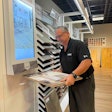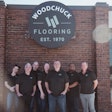
 Shutterstock.com | smutny pan
Shutterstock.com | smutny pan
If there's one thing that will keep wood flooring retailers awake at night, it's cash flow. More often than not, when I get calls from prospective clients, they're calling because they're struggling with cash flow. They may state it in different terms, perhaps that they're concerned about too much inventory, excessive markdowns, poor planning or weak margins. These problems are leading to the larger problem, the problem that's really causing the sleepless nights: poor cash flow.
Cash flow is the lifeblood of any wood flooring retailer, large or small. Without cash flow there is nothing. When cash flow is positive, there's a tomorrow. When cash flow is negative, there's an abyss.
Ways Retailers Bleed Cash
There are a number of different ways a wood flooring retailer can bleed cash. Some are more obvious than others, but wood flooring retailers are susceptible to all of them. Let's take a look at some of them:
1) Excess Inventory
Typically, most of a small retailer's assets are tied up in inventory, in some cases as much as 80 percent to 90 percent of those assets. This makes small retailers unique from many other small businesses: Inventory is the critical cash-generating asset of any retailer.
Unfortunately, inventory also has a funny way of consuming available cash. New items, new categories, broader assortments, greater depth of stock—there's always something to buy and (what seems like) a good reason to buy it. Carrying too much inventory, or the wrong inventory, consumes valuable cash. All too frequently when a small retailer wants to know where the cash has gone, I can walk them out to their warehouse and show them their cash, hiding in broad daylight, disguised as inventory.
I recommend maintaining lean inventory levels. Simply defined, lean inventory is the sweet spot between having the inventory needed to support the sales forecasts and having the burdens and risks of excess inventory. Maintaining lean inventories requires that inventory levels be actively managed.
2) Excessive Markdowns
Frequently, too much inventory leads directly to excessive markdowns. All of that cash disguised as inventory has to be turned back into cash somehow, the retailer thinks. But if too much inventory drained cash in the first place, marking it down to clear it out (though absolutely necessary) won't resolve the cash crunch, because the retailer is not generating full margins on those sales. The heavy discounting associated with excessive markdowns all too often leaves too little cash to pay the accumulating backlog of payables or fund the purchase of next season's merchandise.
Preseason planning can prevent the excessive breadth and depth of assortments that lead to markdowns. Forecasting sales and closely aligning inventory levels to those forecasts prevents the buildup of excess inventory. Flowing merchandise throughout the season, as close as possible to the planned time of sale, keeps things fresh, promotes a sense of urgency in customers and allows the retailer to respond to the sales trend, thus minimizing markdown risk.
Promotional discounting also impacts margins. Many retailers now feel compelled to discount to drive sales. An increased level of discounting, however, places enormous strains on cash flow. Like markdowns, promotional discounting doesn't generate full margins—the cash needed to pay the merchandise payables and all of the other expenses of the business.
3) Margin Erosion
When markdowns are excessive, margins are clearly impacted. But margin erosion, the slow but steady decline in overall margin percentage, while far subtler, can have just as serious an impact on cash flow. It can result from not maintaining margins in the face of cost increases from vendors, or in bumping up against natural price points. Again, as margins erode, there's simply not enough cash being generated to cover the merchandise payables, much less the other expenses of the business.
4) Excessive Payroll
As carefully as most small retailers watch their expenses, payroll as a percentage of sales has a funny way of creeping up, up, up. It's pretty easy to understand why. Every independent retailer wants to be sure there is enough staff to work with customers at all times. Many independent retailers are family-run businesses, and one of their core values is to run the business like a family. When sales take a dip, an owner frequently is loath to lay off anybody, cut back hours or even scale back annual raises and bonuses. The thinking usually goes something like this, "I'll find someplace else to cut back. I'm not going to cut payroll unless I absolutely have to." By then, cash flow is usually under pretty significant stress.
5) Capital Expenditures
Here's one place where cash can vaporize in a real hurry. In the mid 2000s, when times were good, there was so much cash coming in that it was easy to assume the good times, and the cash, would just keep coming. Many small retailers decided to aggressively invest in their businesses, all too often without a sober assessment of the return the investment would generate. When business suddenly hit a wall at the end of the decade, many were caught short on cash with investments that weren't beginning to generate the sales necessary to refill the coffers. Of course, it doesn't take a downturn in business for an ill-advised investment to leave a small retailer grasping for cash.
6) Poor Planning
I've said it time and again, and I'll keep on saying it: Show me a small retailer who truly takes the time to plan out their business, and I'll show you a successful small retailer. If sales and inventory levels haven't been adequately planned, there's no way of quantifying how much merchandise should be brought in each month. And if cash flow isn't being planned, if there isn't a series of budgets and benchmarks for cash outflows, as a sales plan provides a budget and benchmarks for cash inflows, there's no way of assuring that each month is generating the necessary cash flow to sustain the business.
Detailed sales forecasting identifies and quantifies where opportunities are, while assuring that the overall forecast is realistic. Sales forecasting provides direction and purpose to a season. It's the first step in deciding how best to allocate resources.
The best sales forecasts, however, don't just forecast sales dollars, they also forecast the components of sales dollars, unit sales and average selling price. A 5 percent increase with a 15 percent increase in units but a 5 percent decrease in average selling price is likely to put a lot of pressure on average selling prices and margins. Alternatively, a 5 percent increase with a 5 percent increase in units and no change in the average selling price won't create downward pressures on average selling prices or margins.
In the end, the key is budgeting and benchmarking so there is a dynamic plan that assures the business is able to provide for its cash needs and identify potential pinch points in future months, when there's still the time to develop a corrective plan of action. With a cash flow plan, there's a pathway to success before for a retailer, as well as a good night's sleep.
































